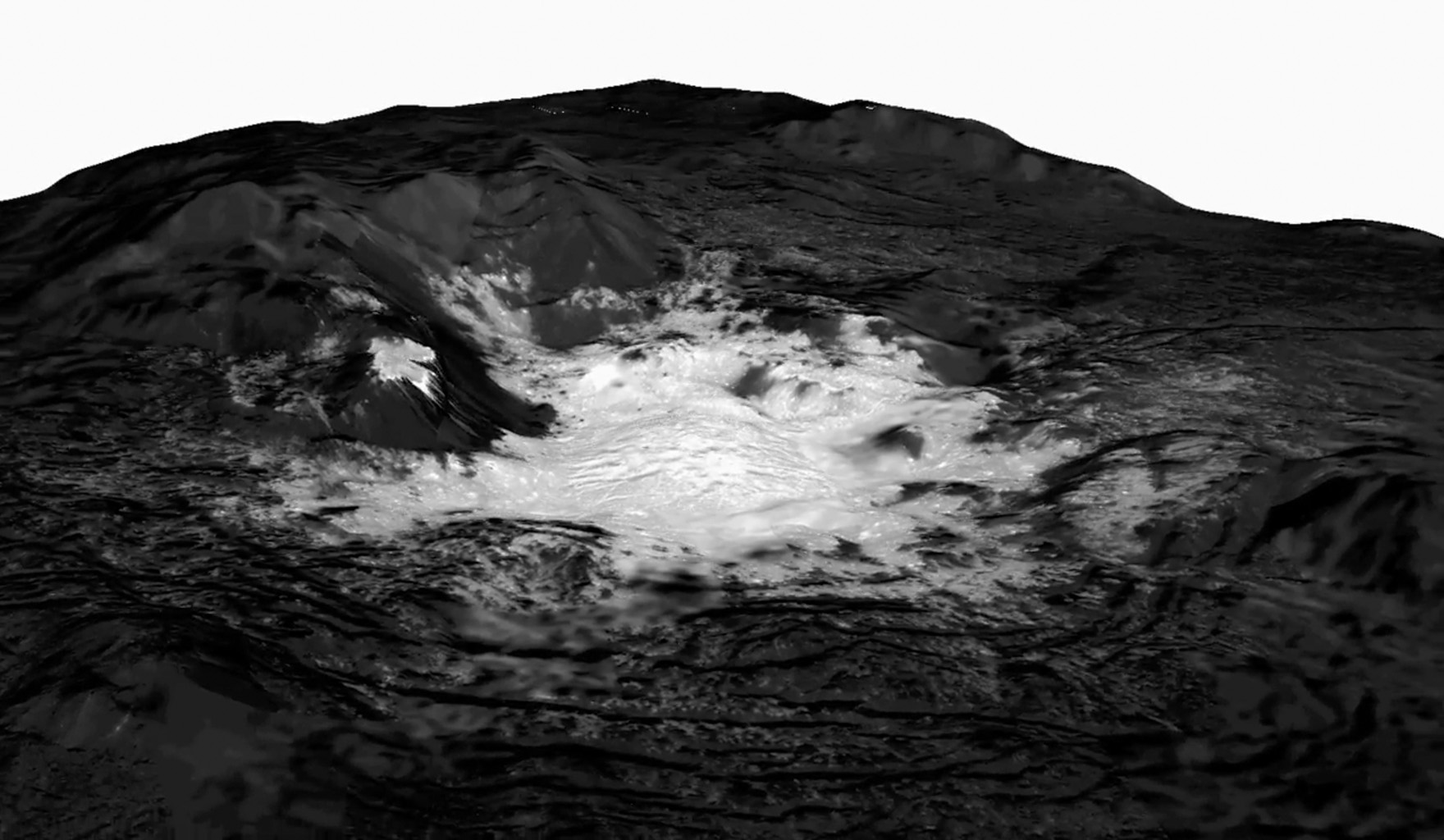Simulations at the Jackson School Highlight Geologic Activity on Ceres
August 19, 2020
 When NASA’s Dawn spacecraft flew a mere 22 miles above the surface of Ceres in 2015, this dwarf planet –the largest object in the asteroid belt—was found to be geologically active. Data recorded during the fly-by transformed astronomers’ impressions of Ceres from an inert, chilly object into a planetary body blanketed by rock and ice that is dotted with unusual features, including cryovolcanoes that spew salty liquid, ice flows and landslides, and bright areas composed of dried salty water.
When NASA’s Dawn spacecraft flew a mere 22 miles above the surface of Ceres in 2015, this dwarf planet –the largest object in the asteroid belt—was found to be geologically active. Data recorded during the fly-by transformed astronomers’ impressions of Ceres from an inert, chilly object into a planetary body blanketed by rock and ice that is dotted with unusual features, including cryovolcanoes that spew salty liquid, ice flows and landslides, and bright areas composed of dried salty water.
It is the latter feature—the bright deposits—and the lingering questions about their origin that are highlighted in a series of simultaneously released research articles published on August 10, 2020. How old are these salty geological features? What is the source of the brine that dried to sodium carbonate and other salts?
One of the research papers is tackling these questions using computational modeling of an asteroid impact to Ceres and the subsequent cooling of material. This paper, published in Nature Astronomy, is the work of Jackson School of Geosciences researcher Marc Hesse and colleagues at numerous other institutions.
“The salt crust that looks like shining lights on Ceres is not found elsewhere in the solar system,” said Hesse, an associate professor in the Department of Geosciences at The University of Texas at Austin and co-author to the study. “We were interested in how the bright spots formed within one impact crater, Occator, and whether the impact created all of the brine under the surface.”
Ceres is the largest of the asteroids populating the dark space between Mars and Jupiter. Discovered over two centuries ago, it is not visible without a telescope. The notable bright regions indicating a crust of salt are found all across Ceres, although those associated with the Occator Crater are the brightest, most likely because they are the youngest.
This crater has been dated at ~20 million years old by estimating the frequency of subsequent impacts visible on the surface.
The new paper uses gravitational data to peek beneath the surface of the Occator Crater. Using images collected in 2018 that were ten times higher in resolution than those taken previously, Anton Ermakov, one of the authors affiliated with the University of California in Berkeley, discovered a low-density anomaly below the surface that is thought to be a deep reservoir of brine that existed before the impact.
“The bulk of the salts were supplied from a slushy area just beneath the surface that was melted by the heat of the impact that formed the crater about 20 million years ago,” said Carol Raymond, Principal Investigator for the Dawn mission. Raymond is the first author of the paper.
To determine whether these salts could have come only from the impact or also stemmed from additional sources, co-author Brandon Johnson of Purdue University modeled the crater-forming impact, which punched a 25 km deep and 7 to 10 km wide hole into Ceres icy crust. Hesse took it from there, using these data as a starting point to simulate how Ceres cooled over the following 20 million years. He found that the initial melt generated by the impact produced heat would have to have frozen within about 5 million years, indicating that the melt formed during the impact cannot be the source of the cryovolcanic activity 20 million years after crater formation. This result suggests the presence of a pre-existing subsurface salt water reservoir, the one identified by Anton Ermakov, because this must have been the source of additional material after the cooling of the initial impact.
“The impact heat subsided after a few million years,” said Raymond. “However, the impact also created large fractures that could reach the deep, long-lived reservoir, allowing brine to continue percolating to the surface.”
“It was only about 20 years ago that Ceres was thought to be a dead snowball. Now it is considered a potential ocean world that has retained deep brine over its long history. These deep fluids have likely been tapped by the impact that formed Occator crater and brought them to the surface,” added Hesse.
Additional authors on the Nature Astronomy paper include J. C. Castillo-Rogez, R. S. Park, J. T. Keane and M. D. Rayman of the Jet Propulsion Laboratory, California Institute of Technology; S. Marchi of the Southwest Research Institute; D. L. Buczkowski of Johns Hopkins University Applied Physics Laboratory; H. G. Sizemore and T. H. Prettyman of the Planetary Science Institute; P. M. Schenk of the Lunar and Planetary Institute; A. Nathues of Max Planck Institute for Solar System Research; L. C. Quick of NASA Goddard Space Flight Center; and C. T. Russell of University of California at Los Angeles.
Written by Kristin Phillips, Department of Geological Sciences